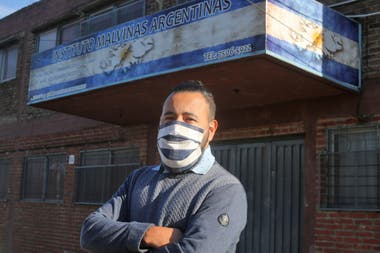In Argentina, behind the glimmers of prosperity and progress, lies a stark reality of chronic poverty that persists through generations. Meet Otilia Torrez, a 45-year-old woman who, like her parents, never had the opportunity to attend school. Growing up with her twelve siblings in the Santiago area of Lot 26, Otilia began working in the cotton harvest at the age of nine, perpetuating the cycle of poverty in her family.
Today, Otilia and her family reside in Añatuya, facing a lack of basic necessities such as electricity, and relying on fetching water from a well with buckets. Their story is just one of the many thousands that form the hard core of marginality in Argentina.
A recent study has shed light on these chronic poor households, revealing that they face persistent deficiencies that remain unresolved even during favorable economic conditions. To help understand the distribution of chronic poverty, a digital platform known as the “Map of Georeference of Chronic Poverty in Argentina” has been launched. This platform, a collaborative effort between the Center for the Implementation of Public Policies for Equity and Growth (Cippec) and other organizations, offers exclusive insights into the geographical concentration of chronic poverty, breaking it down by provinces, departments, and census radio.
According to the study’s findings, the Buenos Aires suburbs and the Pampas region each hold 24% of the chronic poor, followed by the NEA with 22%, the NOA with 19%, and Cuyo with 8%. In contrast, Patagonia and the city of Buenos Aires account for only 2% and 1% of the chronic poor, respectively.
A critical challenge lies in the fact that 16% of the country’s departments (82 out of 512) have alarmingly high levels of marginality. In these municipalities, over a quarter of the population lives submerged in chronic poverty, with 16% of them experiencing rates exceeding 40%.
Addressing this complex issue requires comprehensive and federal policies that consider the unique characteristics of each region. Minister of Social Development, Daniel Arroyo, emphasizes the need for collaboration with provinces and municipalities to design specific measures that tackle poverty effectively.
The collaborative study by Cippec, UNDP, ODSA, and Cedlas aims to inform policy development to eradicate poverty in Argentina. By offering detailed georeferencing of poverty, the platform reveals invisible inequalities that persist across both prosperous districts and historically disadvantaged regions. Chronic poverty is a pervasive issue affecting urban and rural areas from north to south and east to west.
While the challenges are immense, the map serves as an essential tool for directing public resources strategically, enabling targeted interventions to uplift those trapped in the cycle of chronic poverty. The data also highlights critical areas with higher prevalence, such as Chaco and Corrientes in the Northeast, and Formosa and Santiago del Estero in the Northwest.
As Argentina continues its pursuit of progress and equality, addressing chronic poverty and its underlying causes must remain a top priority. With the insights provided by the “Map of Inequality,” policymakers and stakeholders can work collectively to create a more equitable and inclusive society for all Argentinians.
Unveiling the Map of Chronic Poverty: A Struggle for Progress and Equity
Continuing from our previous analysis, the newly launched “Map of Georeference of Chronic Poverty in Argentina” provides crucial insights into the chronic poor households, who grapple with persistent deficiencies even in favorable economic conditions. This map offers a glimpse into the most vulnerable 10% of Argentine households, shedding light on the characteristics that keep them entrapped in poverty.
Gala Díaz Langou, the director of Social Protection at Cippec, clarifies that this relative measure complements income poverty and multidimensional assessments, seeking to understand why chronic poverty persists, particularly within the most deprived 10% of households. Leonardo Gasparini, director of Cedlas, explains that overcoming chronic poverty requires either ambitious interventions across various aspects such as income, employment, housing, infrastructure, and education, or sustained economic growth generating opportunities for all segments of the population.
A comprehensive strategy to eradicate poverty revolves around three key axes: income guarantee through labor market and social protection, investment in human development and habitat, and an institutional and financing axis to coordinate and ensure strategic lines. Collaboration between the national government, provinces, and municipalities is essential to achieve this goal.
The map pinpoints specific indicators, such as households with critical overcrowding or children between 6 and 17 not attending school. For instance, Florencio Varela and Marcos Paz exhibit higher percentages of children not attending school, while Vicente López and San Isidro fare better.
The profile of the chronic poor reveals that almost half are under 15 years old, with 70% having less than 9 years of education. The average household size is over six people, and 70% face unsatisfied basic needs. Adequate sanitation access is limited to only 28.9% of households. The majority of workers are salaried in small firms, some are unskilled self-employed, and others work as street vendors, in construction, or domestic service. Rural areas face different challenges, such as limited educational opportunities, restricted healthcare access, and fragile employment conditions.
It is evident that chronic poverty, being intergenerational, persists over time, with structural issues extending beyond mere monetary concerns. Addressing this deeply rooted problem requires a multi-faceted approach that prioritizes those trapped in vulnerability. As we strive for growth and progress, it is crucial to remember those whose struggle for a better life remains a top priority for Argentina’s inclusive development. By combining all available instruments and dedicating focused efforts to these marginalized groups, we can pave the way for a more equitable and prosperous future.
Publicado en el diario La Nación




